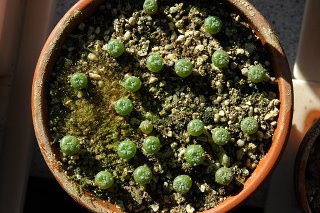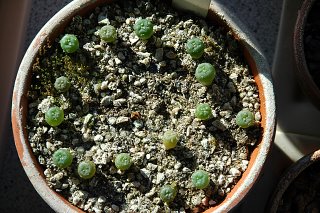Today I sowed this years first batch of seeds - 30 each of:
- Lophophora williamsii (VM 305k; Sierra de la Paila, Coahuila)
- Lophophora williamsii (VM 183k; Hipolito, Coahuila)
- Obregonia denegrii v. prerovskyana nom. prov. (KMR 38; Cinco de Mayo, Tamaulipas)
 Lophophora williamsii seedlings (RS 428A; Cuatro Ciénegas, Coahuila)
It's amazing that cactus seedlings can thrive for a year in the humid environment of a sowing bag (notice the green stuff among the seedlings - it's moss!), but it seems to become them well.
Lophophora williamsii seedlings (RS 428A; Cuatro Ciénegas, Coahuila)
It's amazing that cactus seedlings can thrive for a year in the humid environment of a sowing bag (notice the green stuff among the seedlings - it's moss!), but it seems to become them well.
 Lophophora diffusa seedlings (RS 1193; Peña Miller, Queretaro)
The benefits of growing in bags are many, e.g. you don't need to water often and most pests like red spider mites are avoided (on the other hand you have to be careful not to let in sciarid flies). On the downside, the plants seem slightly leggy - probably because they haven't been fully dormant throughout winter.
Lophophora diffusa seedlings (RS 1193; Peña Miller, Queretaro)
The benefits of growing in bags are many, e.g. you don't need to water often and most pests like red spider mites are avoided (on the other hand you have to be careful not to let in sciarid flies). On the downside, the plants seem slightly leggy - probably because they haven't been fully dormant throughout winter.



















They look very geen :)
ReplyDeleteThe seedlings are very close to each other. How old are the plants when you move them to different pots? And how many plants do you have in one pot (e.g. diameter 11cm)?
Usually I’m sowing 30 seeds per pot (I’m using 11cm ~ 4'' pots) which amounts to 15-25 – in exceptional cases 30 – plants. I’m leaving the seedlings in the pot for at least a year, generally longer. They are repotted when they start to get crammed.
ReplyDeleteWhy limestone gravel? All cacti require slightly acidic soil; when exposed to water the gravel will make the soil highly alkaline.
ReplyDeleteLophophora, Ariocarpus, etc. grow in calcareous soil in their natural habitat. I don't know where you got the information that "all cacti require slightly acidic soil" - these species seem to think otherwise ;-)
ReplyDeleteI'm trying to emulate the plants natural growing conditions, but they might actually thrive in acidic soil. It would be an interesting experiment to compare plants growing in calcareous/acidic soil but otherwise having similar conditions.
Another note on limestone gravel - I found the information quoted below at the Living Rocks site.
ReplyDelete"Contrary to a common misconception, limestone soils are not highly alkaline - limestone itself is virtually insoluble in water and the amount of calcium bicarbonate, which has only a very mildly alkaline reaction, produced at any one time is tiny and transient as it is quickly consumed by neutralizing acidic constituents in the soil
(humic acids etc.), facilitating the release of essential minerals from complex clay structures and by the plant itself. [...]
Horticultural or hydrated lime - calcium hydroxide - must NOT be used in any circumstances as this does have a strongly alkaline reaction and will damage the roots of plants."
I think I'll stick to using limestone gravel in my soil ;-)
I was wondering if anyone can tell me why my seedling are growing tall and skinny. Only some are though. Around half are normal looking.
ReplyDeleteUsually etiolation is caused by too low light levels - are the elongated seedlings growing under the exact same conditions as the normal ones?
ReplyDeleteYes they are all grown in the exact same conditions. I have brought them inside for winter and it seems more are begining to do this. Is this going to make them grow funny after I put them in the summer sun?
ReplyDeleteThanks
Are you cutting back on water to bring the plants into dormancy? If the plants keep growing during the low winter light levels they'll definitely grow leggy (unless you use artificial light).
ReplyDeleteIt's hard to say if the plants will retain their etiolated growth habit, but young seedlings should be able to revert to a more normal form when growing older.
I used to be able to get "Lophophora williamsii" seeds froma mail ordercatalog and can't find them any more.. can you help?
ReplyDeleteJerry Van rainman@i-c.net
The retailers I've done business with are listed on the seed and plant retailers page.
ReplyDeletein you experiance, what is the average time it takes the seeds to sprout? i have a few L. williamsii seeds i planted two weeks agoand haven't seen any sprout yet (i have them in a warm humid environment so i dont think thats a problem and the seeds were planted fresh from the pod)
ReplyDeleteIn two weeks I would expect a large fraction of the seeds to germinate. I'm germinating my seeds at a temperature of about 25 C (~77 F) and at 100% humidity. The seeds are sown directly on top of the soil and lightly pressed into it, I'm not covering the seeds apart from that. While germinating the seeds are exposed to light, but no direct sunlight.
ReplyDeleteUsually Lophophora seeds are easy to germinate and have very generous germination rates - could your seeds be too old or not fertilized properly? Anyway, I would leave the seeds and see if anything germinates in the coming weeks.
Hi, about 4 weeks ago I planted some L diffusa seeds for the first time in bags on a heat tray near a window. I sneaked a look recently and most seeds appeared not to have germinated. I found 1 tiny green ball but am unsure if it's a cactus or just some green bit of cactus mix as it is very dark green. Could this be a cactus and are the other seeds likely to germinate?
ReplyDeleteIn my experience a large fraction (40-90%) of the seeds will usually germinate in 2-3 weeks, with a few runner-ups in the following weeks. That being said, I would leave the seeds for some month to see if more germinate. If your small green ball is a cactus, it should swell noticeably in the weeks to come; alternatively you can use a loupe to check it right away.
ReplyDeleteIs the moss a danger to the health of the youngsters? I am having a similar experience in my high humidity environment.
ReplyDeleteAs long as the moss doesn't outgrow and cover the seedlings I haven't experienced any ill effects. If the moss threatens to take over the pot, just remove it from the bag and the drier environment quickly kills it off.
ReplyDelete